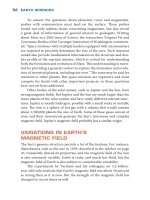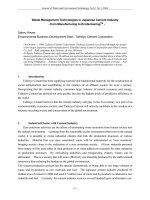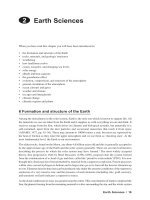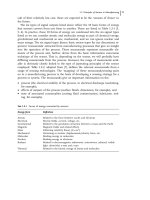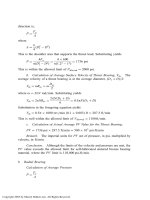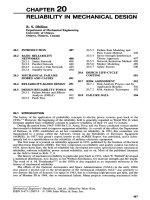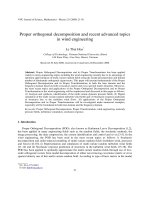- Trang chủ >>
- Khoa Học Tự Nhiên >>
- Vật lý
Advanced Technologies in Earth Sciences pptx
Bạn đang xem bản rút gọn của tài liệu. Xem và tải ngay bản đầy đủ của tài liệu tại đây (42.99 MB, 589 trang )
Advanced Technologies in Earth Sciences
Editors:
L. Stroink, Germany
V. Mosbrugger, Germany
G. Wefer, Germany
For further volumes:
/>
Frank Flechtner · Thomas Gruber ·
Andreas Güntner · Mioara Mandea ·
Markus Rothacher · Tilo Schöne · Jens Wickert
Editors
System Earth via
Geodetic-Geophysical Space
Techniques
123
Editors
Dr. Frank Flechtner
Helmholtz Centre Potsdam
GFZ German Research
Centre for Geosciences
Telegrafenberg
14473 Potsdam
Germany
frank.fl
Prof. Dr. Mioara Mandea
Université Paris Diderot -
Institut de Physique du
Globe de Paris
Géophysique spatiale et
planétaire - Bâtiment
Lamarck
Case 7011, 5 rue Thomas Mann
75205 Paris Cedex 13, France
Dr. Jens Wickert
Helmholtz Centre Potsdam
GFZ German Research
Centre for Geosciences
Telegrafenberg
14473 Potsdam
Germany
Dr. Thomas Gruber
TU München
Arcisstr. 21
80333 München
Germany
Prof. Dr. Markus Rothacher
ETH Zürich
Photogrammetrie
HPV G 52
Schafmattstr. 34
8093 Zürich
Dr. Andreas Güntner
Helmholtz Centre Potsdam
GFZ German Research
Centre for Geosciences
Telegrafenberg
14473 Potsdam
Germany
Dr. Tilo Schöne
Helmholtz Centre Potsdam
GFZ German Research
Centre for Geosciences
Telegrafenberg
14473 Potsdam
Germany
ISSN 2190-1635 e-ISSN 2190-1643
ISBN 978-3-642-10227-1 e-ISBN 978-3-642-10228-8
DOI 10.1007/978-3-642-10228-8
Springer Heidelberg Dordrecht London New York
Library of Congress Control Number: 2010924887
© Springer-Verlag Berlin Heidelberg 2010
This work is subject to copyright. All rights are reserved, whether the whole or part of the material is
concerned, specifically the rights of translation, reprinting, reuse of illustrations, recitation, broadcasting,
reproduction on microfilm or in any other way, and storage in data banks. Duplication of this publication
or parts thereof is permitted only under the provisions of the German Copyright Law of September 9,
1965, in its current version, and permission for use must always be obtained from Springer. Violations
are liable to prosecution under the German Copyright Law.
The use of general descriptive names, registered names, trademarks, etc. in this publication does not
imply, even in the absence of a specific statement, that such names are exempt from the relevant protective
laws and regulations and therefore free for general use.
Cover design: Bauer, Thomas
Printed on acid-free paper
Springer is part of Springer Science+Business Media (www.springer.com)
Preface
Our planet is currently experiencing substantial changes due to natural phenom-
ena and direct or indirect human interactions. Observations from space are the
only means to monitor and quantify these changes on a global and long-term per-
spective. Continuous time series of a large set of Earth system parameters are
needed in order to better understand the processes causing these changes, as well
as their interactions. This knowledge is needed to build comprehensive Earth sys-
tem models used for analysis and prediction of the changing Earth. Geodesy and
geophysics contribute to the understanding of system Earth through the observation
of global parameter sets in space and time, such as tectonic motion, Earth surface
deformation, sea level changes and gravity, magnetic and atmospheric fields.
In the framework of the German geoscience research and development pro-
gramme GEOTECHNOLOGIEN, research projects related to the theme “Observing
the Earth System from Space” have been funded within two consecutive phases
since 2002, both covering 3 years. The projects address data analysis and model
development using the satellite missions CHAMP, GRACE, GOCE and comple-
mentary ground or airborne observations. The results of the first phase projects have
been published in the Springer book, titled “Observation of the Earth System from
Space”, edited by Flury, Rummel, Reigber, Rothacher, Boedecker and Schreiber
in 2006. The present book, titled “System Earth via Geodetic-Geophysical Space
Techniques” summarizes in 40 scientific papers the results of eight coordinated
research projects funded in the second phase of this programme (2005–2008). These
projects partly represent a continuation of the first phase, while some new projects
have been initiated. The book provides an overview of the main outcomes of this
research. At the same time it should inspire future work in this field. The pro-
gramme was funded by the German Federal Ministry of Education and Research
(BMBF). The support of the GEOTECHNOLOGIEN programme by BMBF is
gratefully acknowledged. All projects were carried out in close cooperation between
universities and research institutes.
A total of eight coordinated projects have been carried out. Three of them
address the processing of static and time variable gravity field models from CHAMP,
GRACE and GOCE data including methods for validation (“Improved GRACE
Level-1 and Level-2 Products and their Validation by Ocean Bottom Pressure”,
“More accurate and faster available CHAMP and GRACE Gravity Fields for
v
vi Preface
the User Community” and “Gravity and steady-state Ocean Circulation Explorer
GOCE”). The papers related to CHAMP and GRACE provide deeper insight into
the sensors, the processing methods and the applied algorithms. Results of orbit and
gravity field determination including validation are presented as well. As GOCE was
not yet in orbit during the project period, the rationale of GOCE gravity gradient pro-
cessing to static geoid solutions and their validation are described in several papers.
Two out of the eight coordinated projects are related to applications of GRACE
results, altimeter, GPS and other data for geophysical analyses (“Time-Variable
Gravity and Surface Mass Processes: Validation, Processing and First Application
of New Satellite Gravity Data”; “Sea Level Variations – Prospects from the Past to
the Present”). The papers in these chapters focus on the use of geodetic observa-
tions for assessing variations in the global water cycle and the analysis of sea level
variations derived from satellite altimetry and observations taken at GPS and tides
gauge stations. The remaining three chapters address contributions to the Global
Geodetic-Geodynamic Observing System (GGOS), the atmospheric sounding by
the geodetic based GPS radio occultation technique with CHAMP and GRACE and
the observation of the Earth’s magnetic field with CHAMP (“Integration of Space
Geodetic Techniques as the Basis for a Global Geodetic-Geophysical Observing
System – GGOS-D”, “Near-Real-Time Provision and Usage of Global Atmospheric
Data from GRACE and CHAMP” and “The Earth’s Magnetic Field: At the CHAMP
Satellite Epoch”). The articles in the GGOS section address the consistent pro-
cessing of space-geodetic data, combination techniques and solutions for a global
terrestrial reference frame. Results of atmospheric sounding using GPS radio occul-
tation with CHAMP and GRACE are summarized in the subsequent chapter. Special
focus is hereby given to the near-real time satellite data analysis, fundamental pre-
condition for the application of the innovative GPS occultation data to improve
global weather forecast. Finally, a review paper describes the progress made in
magnetic field modelling during the CHAMP era.
In order to ensure high quality of the papers included in this book a review pro-
cess was conducted before publication. The editors would like to thank all internal
and external reviewers for their valuable contributions, which significantly helped
to improve the quality of the book. The editors are indebted to all authors and to the
publisher for the excellent cooperation when preparing this book. Sabine Lange and
Anja Schlicht of the German GOCE project office at the Technische Universität
München coordinated the editing process and the compilation of the book. The
editors gratefully acknowledge their valuable support.
Potsdam, Germany Frank Flechtner
October 2009 Thomas Gruber
Andreas Güntner
Mioara Mandea
Markus Rothacher
Tilo Schöne
Jens Wickert
Contents
Part I CHAMP and GRACE
More Accurate and Faster Available CHAMP and GRACE
Gravity Fields for the User Community 3
Frank Flechtner
The CHAMP/GRACE User Portal ISDC 15
Bernd Ritschel, Lutz Gericke, Ronny Kopischke, and Vivien Mende
Improvements for the CHAMP and GRACE Observation Model 29
Grzegorz Michalak and Rolf König
The Release 04 CHAMP and GRACE EIGEN Gravity Field Models 41
Frank Flechtner, Christoph Dahle, Karl Hans Neumayer,
Rolf König, and Christoph Förste
Orbit Predictions for CHAMP and GRACE 59
Krzysztof Snopek, Daniel König, and Rolf König
Rapid Science Orbits for CHAMP and GRACE Radio
Occultation Data Analysis 67
Grzegorz Michalak and Rolf König
Parallelization and High Performance Computation
for Accelerated CHAMP and GRACE Data Analysis 79
Karl Hans Neumayer
Part II GRACE
Improved GRACE Level-1 and Level-2 Products
and Their Validation by Ocean Bottom Pressure 95
Frank Flechtner
The GRACE Gravity Sensor System 105
Björn Frommknecht and Anja Schlicht
vii
viii Contents
Numerical Simulations of Short-Term
Non-tidal Ocean Mass Anomalies 119
Henryk Dobslaw and Maik Thomas
Improved Non-tidal Atmospheric and Oceanic De-aliasing
for GRACE and SLR Satellites 131
Frank Flechtner, Maik Thomas, and Henryk Dobslaw
Global Gravity Fields from Simulated Level-1 GRACE Data 143
Ulrich Meyer, Björn Frommknecht, and Frank Flechtner
ITG-GRACE: Global Static and Temporal Gravity Field Models
from GRACE Data 159
Torsten Mayer-Gürr, Annette Eicker, Enrico Kurtenbach,
and Karl-Heinz Ilk
Validation of GRACE Gravity Fields by In-Situ Data of Ocean
Bottom Pressure 169
Andreas Macrander, Carmen Böning, Olaf Boebel, and Jens Schröter
Antarctic Circumpolar Current Transport Variability in
GRACE Gravity Solutions and Numerical Ocean Model Simulations . . 187
Carmen Böning, Ralph Timmermann, Sergey Danilov,
and Jens Schröter
Part III GOCE
Gravity and Steady-State Ocean Circulation Explorer GOCE 203
Reiner Rummel and Thomas Gruber
GOCE Data Analysis: From Calibrated Measurements
to the Global Earth Gravity Field 213
Jan Martin Brockmann, Boris Kargoll, Ina Krasbutter,
Wolf-Dieter Schuh, and Martin Wermuth
GOCE and Its Use for a High-Resolution Global Gravity
Combination Model 231
Richard Shako, Christoph Förste, Oleg Abrikosov,
and Jürgen Kusche
Spectral Approaches to Solving the Polar Gap Problem 243
Oliver Baur, Jianqing Cai, and Nico Sneeuw
Regionally Refined Gravity Field Models from In-Situ Satellite Data . . 255
Annette Eicker, Torsten Mayer-Gürr, Karl-Heinz Ilk,
and Enrico Kurtenbach
Quality Evaluation of GOCE Gradients 265
Jürgen Müller, Focke Jarecki, Insa Wolf, and Phillip Brieden
Contents ix
Validation of Satellite Gravity Field
Models by Regional Terrestrial Data Sets 277
Johannes Ihde, Herbert Wilmes, Jan Müller, Heiner Denker,
Christian Voigt, and Michael Hosse
Comparison of GRACE and Model-Based Estimates of Bottom
Pressure Variations Against In Situ Bottom Pressure Measurements . . 297
Detlef Stammer, Armin Köhl, Vanya Romanova,
and Frank Siegismund
Part IV SEAVAR
Sea Level Variations – Prospects from the Past to the Present
(SEAVAR) 313
Tilo Schöne and Jens Schröter
Radar Altimetry Derived Sea Level Anomalies – The Benefit of
New Orbits and Harmonization 317
Tilo Schöne, Saskia Esselborn, Sergei Rudenko,
and Jean-Claude Raimondo
Combining GEOSAT and TOPEX/Poseidon Data by Means
of Data Assimilation 325
Manfred Wenzel and Jens Schröter
Reanalysis of GPS Data at Tide Gauges and the Combination
for the IGS TIGA Pilot Project 335
Sergei Rudenko, Daniela Thaller, Gerd Gendt,
Michael Dähnn, and Tilo Schöne
Sea Level Rise in North Atlantic Derived from Gap Filled Tide
Gauge Stations of the PSMSL Data Set 341
Heiko Reinhardt, Dimitry Sidorenko, Manfred Wenzel,
and Jens Schröter
Using ARGO, GRACE and Altimetry Data to Assess the Quasi
Stationary North Atlantic Circulation 351
Falk Richter, Dimitry Sidorenko, Sergey Danilov, and Jens Schröter
A 15-Year Reconstruction of Sea Level Anomalies Using Radar
Altimetry and GPS-Corrected Tide Gauge Data 359
Nana Schön, Saskia Esselborn, and Tilo Schöne
Part V TIVAGAM
Continental Water Storage Variations from GRACE
Time-Variable Gravity Data 369
Andreas Güntner
x Contents
Surface Mass Variability from GRACE
and Hydrological Models: Characteristic Periods and the
Reconstruction of Significant Signals 377
Svetozar Petrovic, Roland Braun, Franz Barthelmes,
Johann Wünsch, Jürgen Kusche, and Rico Hengst
Time-Space Multiscale Analysis and Its Application to GRACE
and Hydrology Data 387
Willi Freeden, Helga Nutz, and Kerstin Wolf
Mass Variation Signals in GRACE Products
and in Crustal Deformations from GPS: A Comparison 399
Martin Horwath, Axel Rülke, Mathias Fritsche,
and Reinhard Dietrich
Monthly and Daily Variations of Continental Water Storage
and Flows 407
Kristina Fiedler and Petra Döll
Calibration of a Global Hydrological Model with GRACE Data 417
Susanna Werth and Andreas Güntner
Part VI NRT-RO
Near-Real-Time Provision and Usage of Global
Atmospheric Data from CHAMP and GRACE (NRT-RO):
Motivation and Introduction 429
Jens Wickert
Global Atmospheric Data from CHAMP and GRACE-A:
Overview and Results 433
Jens Wickert, Georg Beyerle, Carsten Falck, Sean B. Healy,
Stefan Heise, Wolfgang Köhler, Grzegorz Michalak, Dave Offiler,
Detlef Pingel, Markus Ramatschi, Markus Rothacher,
and Torsten Schmidt
Near-Real Time Satellite Orbit Determination for GPS Radio
Occultation with CHAMP and GRACE 443
Grzegorz Michalak and Rolf König
The Operational Processing System for GPS Radio Occultation
Data from CHAMP and GRACE 455
Torsten Schmidt, Jens Wickert, and Grzegorz Michalak
Assimilation of CHAMP and GRACE-A Radio Occultation
Data in the GME Global Meteorological Model of the German
Weather Service 461
Detlef Pingel, Andreas Rhodin, Werner Wergen,
Mariella Tomassini, Michael Gorbunov, and Jens Wickert
Contents xi
Part VII MAGFIELD
The Earth’s Magnetic Field at the CHAMP Satellite Epoch 475
Mioara Mandea, Matthias Holschneider, Vincent Lesur,
and Hermann Lühr
Part VIII GGOS-D
Integration of Space Geodetic Techniques as the Basis for a
Global Geodetic-Geophysical Observing System (GGOS-D):
An Overview 529
Markus Rothacher, Hermann Drewes, Axel Nothnagel,
and Bernd Richter
GGOS-D Data Management – From Data
to Knowledge 539
Wolfgang Schwegmann and Bernd Richter
GGOS-D Consistent, High-Accuracy Technique-Specific Solutions 545
Peter Steigenberger, Thomas Artz, Sarah Böckmann, Rainer Kelm,
Rolf König, Barbara Meisel, Horst Müller, Axel Nothnagel,
Sergei Rudenko, Volker Tesmer, and Daniela Thaller
GGOS-D Global Terrestrial Reference Frame 555
Detlef Angermann, Hermann Drewes, Michael Gerstl,
Barbara Meisel, Manuela Seitz, and Daniela Thaller
GGOS-D Consistent and Combined Time Series
of Geodetic/Geophyical Parameters 565
A. Nothnagel, T. Artz, S. Böckmann, N. Panafidina, M. Rothacher,
M. Seitz, P. Steigenberger, V. Tesmer, and D. Thaller
GGOS-D Integration with Low Earth Orbiters 577
Daniel König and Rolf König
Index 583
Contributors
Oleg Abrikosov Helmholtz Centre Potsdam, GFZ German Research Centre for
Geosciences, Department 1: Geodesy and Remote Sensing, Telegrafenberg, 14473
Potsdam, Germany,
Detlef Angermann Deutsches Geodätisches Forschungsinstitut, D-80539
München, Germany, angerman@dgfi.badw.de
Thomas Artz Institut für Geodäsie und Geoinformation, Universität Bonn,
D-53115 Bonn, Germany,
Franz Barthelmes Helmholtz Centre Potsdam, GFZ German Research Centre for
Geosciences, Department 1: Geodesy and Remote Sensing, Telegrafenberg, 14473
Potsdam, Germany,
Oliver Baur Institute of Geodesy, University of Stuttgart, 70174 Stuttgart,
Germany,
Georg Beyerle Helmholtz Centre Potsdam, GFZ German Research Centre for
Geosciences, Department 1: Geodesy and Remote Sensing, Telegrafenberg, 14473
Potsdam, Germany,
Sarah Böckmann Institut für Geodäsie und Geoinformation, Universität Bonn,
D-53115 Bonn, Germany,
Olaf Boebel Alfred Wegener Institute for Polar and Marine Research, D-27570
Bremerhaven, Germany,
Carmen Böning Alfred Wegener Institute for Polar and Marine Research,
D-27570 Bremerhaven, Germany,
Roland Braun Department of 1 ‘Geodesy and Remote Sensing’, Helmholtz
Centre Potsdam, GFZ German Research Centre for Geosciences, 14473 Potsdam,
Germany,
Phillip Brieden Institut für Erdmessung, Leibniz Universität Hannover, 30167
Hannover, Germany,
xiii
xiv Contributors
Jan Martin Brockmann Institute of Geodesy and Geoinformation, University of
Bonn, Bonn, Germany,
Jianqing Cai Institute of Geodesy, University of Stuttgart, 70174 Stuttgart,
Germany,
Christoph Dahle Helmholtz Centre Potsdam, GFZ German Research Centre for
Geosciences, Department 1: Geodesy and Remote Sensing, Telegrafenberg, 14473
Potsdam, Germany,
Michael Dähnn Helmholtz Centre Potsdam, GFZ German Research Centre for
Geosciences, Department 1: Geodesy and Remote Sensing, Telegrafenberg, 14473
Potsdam, Germany; Current affiliation: Norwegian Mapping Authority, N-3507
Hønefoss, Norway,
Sergey Danilov Alfred-Wegener-Institute for Polar- and Marine Research,
D-27570 Bremerhaven, Germany,
Heiner Denker Institut für Erdmessung (IfE), Leibniz Universität Hannover,
D-30167 Hannover, Germany,
Reinhard Dietrich Institut für Planetare Geodäsie, Technische Universität
Dresden, 01219 Dresden, Germany,
Henryk Dobslaw Helmholtz Centre Potsdam, GFZ German Research Centre for
Geosciences, Department 1: Geodesy and Remote Sensing, Telegrafenberg, 14473
Potsdam, Germany,
Petra Döll Institute of Physical Geography, Goethe University Frankfurt am Main,
60438 Frankfurt am Main, Germany,
Hermann Drewes Deutsches Geodätisches Forschungsinstitut, D-80539
München, Germany, drewes@dgfi.badw.de
Annette Eicker Institute of Geodesy and Geoinformation, University of Bonn,
53115 Bonn, Germany,
Saskia Esselborn Helmholtz Centre Potsdam, GFZ German Research Centre for
Geosciences, Department 1: Geodesy and Remote Sensing, Telegrafenberg, 14473
Potsdam, Germany,
Carsten Falck Helmholtz Centre Potsdam, GFZ German Research Centre for
Geosciences, Department 1: Geodesy and Remote Sensing, Telegrafenberg, 14473
Potsdam, Germany,
Kristina Fiedler Institute of Physical Geography, Goethe University Frankfurt am
Main, 60438 Frankfurt am Main, Germany, fi
Frank Flechtner Helmholtz Centre Potsdam, GFZ German Research Centre for
Geosciences, Department 1: Geodesy and Remote Sensing, Telegrafenberg, 14473
Potsdam, Germany, frank.fl
Contributors xv
Christoph Förste Helmholtz Centre Potsdam, GFZ German Research Centre for
Geosciences, Department 1: Geodesy and Remote Sensing, Telegrafenberg, 14473
Potsdam, Germany,
Willi Freeden Geomathematics Group, Department of Mathematics, TU
Kaiserslautern, 67653 Kaiserslautern, Germany,
Mathias Fritsche Institut für Planetare Geodäsie, Technische Universität
Dresden, 01219 Dresden, Germany,
Björn Frommknecht RHEA S.A., Louvain La Neuve, Belgium; ESA/ESRIN,
00040 Frascati, Italy, Institut für Astronomische und Physikalische Geodäsie
(IAPG), Technische Universität München, 80333 München, Germany,
Gerd Gendt Helmholtz Centre Potsdam, GFZ German Research Centre for
Geosciences, Department 1: Geodesy and Remote Sensing, Telegrafenberg, 14473
Potsdam, Germany,
Lutz Gericke Helmholtz Centre Potsdam, GFZ German Research Centre for
Geosciences, Centre for GeoInformation Technology, Telegrafenberg, 14473
Potsdam, Germany,
Michael Gerstl Deutsches Geodätisches Forschungsinstitut, D-80539 München,
Germany, gerstl@dgfi.badw.de
Michael Gorbunov Obukhov Institute for Atmospheric Physics, Moscow, Russia,
;
Thomas Gruber Institute of Astronomical and Physical Geodesy, Technische
Universiät München, Munich, Germany,
Andreas Güntner Helmholtz Centre Potsdam, GFZ German Research Centre for
Geosciences, Department 5: Earth Surface Processes, Telegrafenberg, 14473
Potsdam, Germany,
Sean B. Healy European Centre for Medium-Range Forecasts, ECMWF,
Reading, UK,
Stefan Heise Helmholtz Centre Potsdam, GFZ German Research Centre for
Geosciences, Department 1: Geodesy and Remote Sensing, Telegrafenberg, 14473
Potsdam, Germany,
Rico Hengst Department 1 ‘Geodesy and Remote Sensing’, Helmholtz Centre
Potsdam, GFZ German Research Centre for Geosciences, 14473 Potsdam,
Germany,
Matthias Holschneider Institut für Mathematik, Universität Potsdam, 14469
Potsdam, Germany,
Martin Horwath Institut für Planetare Geodäsie, Technische Universität Dresden,
01219 Dresden, Germany,
xvi Contributors
Michael Hosse Institut für Astronomische und Physikalische Geodäsie (IAPG),
Technische Universität München, D-80333 München, Germany,
Johannes Ihde Bundesamt für Kartographie und Geodäsie (BKG), D-60598
Frankfurt am Main, Germany,
Karl-Heinz Ilk Institute of Geodesy and Geoinformation, University of Bonn,
53115 Bonn, Germany,
Focke Jarecki Institut für Erdmessung, Leibniz Universität Hannover, 30167
Hannover, Germany,
Boris Kargoll Institute of Geodesy and Geoinformation, University of Bonn,
Bonn, Germany,
Rainer Kelm Deutsches Geodätisches Forschungsinstitut, D-80539 München,
Germany, kelm@dgfi.badw.de
Armin Köhl Institut für Meereskunde, KlimaCampus, Universität Hamburg,
Hamburg, Germany,
Wolfgang Köhler Helmholtz Centre Potsdam, GFZ German Research Centre for
Geosciences, Department 1: Geodesy and Remote Sensing, Telegrafenberg, 14473
Potsdam, Germany,
Rolf König Helmholtz Centre Potsdam, GFZ German Research Centre for
Geosciences, Department 1: Geodesy and Remote Sensing, Telegrafenberg, 14473
Potsdam, Germany,
Daniel König Helmholtz Centre Potsdam, GFZ German Research Centre for
Geosciences, Department 1: Geodesy and Remote Sensing, Telegrafenberg, 14473
Potsdam, Germany,
Ronny Kopischke Helmholtz Centre Potsdam, GFZ German Research Centre for
Geosciences, Centre for GeoInformation Technology, Telegrafenberg, 14473
Potsdam, Germany,
Ina Krasbutter Institute of Geodesy and Geoinformation, University of Bonn,
Bonn, Germany,
Enrico Kurtenbach Institute of Geodesy and Geoinformation, University of
Bonn, 53115 Bonn, Germany,
Jürgen Kusche University of Bonn, Institute of Geodesy and Geoinformation,
53115 Bonn, Germany,
Vincent Lesur Helmholtz Centre Potsdam, GFZ German Research Centre for
Geosciences, Department 2: Physics of the Earth, Telegrafenberg, 14473 Potsdam,
Germany,
Contributors xvii
Hermann Lühr Helmholtz Centre Potsdam, GFZ German Research Centre for
Geosciences, Department 2: Physics of the Earth, Telegrafenberg, 14473 Potsdam,
Germany,
Andreas Macrander Alfred Wegener Institute for Polar and Marine Research,
D-27570 Bremerhaven, Germany,
Mioara Mandea Helmholtz Centre Potsdam, GFZ German Research Centre for
Geosciences, Department 2: Physics of the Earth, Telegrafenberg, 14473 Potsdam,
Germany; Now at Universitee Paris Diderot, Institut de Physique du Globe de
Paris, France,
Torsten Mayer-Gürr Institute of Geodesy and Geoinformation, University of
Bonn, 53115 Bonn, Germany,
Barbara Meisel Deutsches Geodätisches Forschungsinstitut, D-80539 München,
Germany, meisel@dgfi.badw.de
Vivien Mende Helmholtz Centre Potsdam, GFZ German Research Centre for
Geosciences, Centre for GeoInformation Technology, Telegrafenberg, 14473
Potsdam, Germany,
Ulrich Meyer Helmholtz-Zentrum Potsdam, Deutsches GeoForschungsZentrum
(GFZ), D-82234 Weβling, Germany; Astronomical Institute, University of Bern,
3012 Bern, Switzerland,
Grzegorz Michalak Helmholtz Centre Potsdam, GFZ German Research Centre
for Geosciences, Department 1: Geodesy and Remote Sensing, Telegrafenberg,
14473 Potsdam, Germany,
Jürgen Müller Institut für Erdmessung, Leibniz Universität Hannover, 30167
Hannover, Germany,
Jan Müller Bundesamt für Kartographie und Geodäsie (BKG), D-60598
Frankfurt am Main, Germany,
Horst Müller Deutsches Geodätisches Forschungsinstitut, D-80539 München,
Germany, mueller@dgfi.badw.de
Karl Hans Neumayer Helmholtz Centre Potsdam, GFZ German Research Centre
for Geosciences, Department 1: Geodesy and Remote Sensing, Telegrafenberg,
14473 Potsdam, Germany,
Axel Nothnagel Institut f ür Geodäsie und Geoinformation, Universität Bonn,
D-53115 Bonn, Germany,
Helga Nutz Geomathematics Group, Department of Mathematics, TU
Kaiserslautern, 67653 Kaiserslautern, Germany,
Dave Offiler Met Office, Exeter, UK, dave.offiler@metoffice.gov.uk
xviii Contributors
Natasha Panafidina ETH Zürich, Institute of Geodesy and Photogrammetry,
Zurich Switzerland,
Svetozar Petrovic Helmholtz Centre Potsdam, GFZ German Research Centre for
Geosciences, Department 1: Geodesy and Remote Sensing, Telegrafenberg, 14473
Potsdam, Germany,
Detlef Pingel Deutscher Wetterdienst, DWD, Offenbach, Germany,
Jean-Claude Raimondo Helmholtz Centre Potsdam, GFZ German Research
Centre for Geosciences, Department 1: Geodesy and Remote Sensing,
Telegrafenberg, 14473 Potsdam, Germany,
Markus Ramatschi Helmholtz Centre Potsdam, GFZ German Research Centre
for Geosciences, Department 1: Geodesy and Remote Sensing, Telegrafenberg,
14473 Potsdam, Germany,
Heiko Reinhardt Stiftung Alfred Wegener Institut für Polar und
Meeresforschung, 27570 Bremerhaven, Germany,
Andreas Rhodin Deutscher Wetterdienst, Offenbach, Germany,
Falk Richter Alfred-Wegener-Institute for Polar- and Marine Research, D-27570
Bremerhaven, Germany,
Bernd Richter Bundesamt für Kartographie und Geodäsie, 60598 Frankfurt am
Main, Germany,
Bernd Ritschel Helmholtz Centre Potsdam, GFZ German Research Centre for
Geosciences, Centre for GeoInformation Technology, Telegrafenberg, 14473
Potsdam, Germany,
Vanya Romanova Institut für Meereskunde, KlimaCampus, Universität Hamburg,
Hamburg, Germany,
Markus Rothacher ETH Zürich, Photogrammetrie, HPV G 52, Schafmattstr. 34,
8093 Zürich
Sergei Rudenko Helmholtz Centre Potsdam, GFZ German Research Centre for
Geosciences, Department 1: Geodesy and Remote Sensing, Telegrafenberg, 14473
Potsdam, Germany,
Axel Rülke Institut für Planetare Geodäsie, Technische Universität Dresden,
01219 Dresden, Germany,
Reiner Rummel Institute of Astronomical and Physical Geodesy, Technische
Universiät München, Munich, Germany,
Anja Schlicht Institute for Astronomical and Physical Geodesy, 80333 München,
Germany,
Contributors xix
Torsten Schmidt Helmholtz Centre Potsdam, GFZ German Research Centre for
Geosciences, Department 1: Geodesy and Remote Sensing, Telegrafenberg, 14473
Potsdam, Germany,
Nana Schön Helmholtz Centre Potsdam, GFZ German Research Centre for
Geosciences, Department 1: Geodesy and Remote Sensing, Telegrafenberg, 14473
Potsdam, Germany,
Tilo Schöne Helmholtz Centre Potsdam, GFZ German Research Centre for
Geosciences, Department 1: Geodesy and Remote Sensing, Telegrafenberg, 14473
Potsdam, Germany,
Jens Schröter Alfred Wegener Institute for Polar and Marine Research, D-27570
Bremerhaven, Germany,
Wolf-Dieter Schuh Institute of Geodesy and Geoinformation, University of Bonn,
Bonn, Germany,
Wolfgang Schwegmann Bundesamt für Kartographie und Geodäsie, 60598
Frankfurt am Main, Germany,
Manuela Seitz Deutsches Geodätisches Forschungsinstitut, D-80539 München,
Germany, seitz@dgfi.badw.de
Richard Shako Helmholtz Centre Potsdam, GFZ German Research Centre
for Geosciences, Department 1: Geodesy and Remote Sensing, Telegrafenberg,
14473 Potsdam, Germany,
Dimitry Sidorenko Alfred-Wegener-Institute for Polar- and Marine Research,
D-27570 Bremerhaven, Germany,
Frank Siegismund Institut für Meereskunde, KlimaCampus, Universität
Hamburg, Hamburg, Germany,
Nico Sneeuw Institute of Geodesy, University of Stuttgart, 70174 Stuttgart,
Germany,
Krzysztof Snopek Helmholtz Centre Potsdam, GFZ German Research Centre for
Geosciences, Department 1: Geodesy and Remote Sensing, Telegrafenberg, 14473
Potsdam, Germany,
Detlef Stammer Institut für Meereskunde, KlimaCampus, Universität Hamburg,
Hamburg, Germany,
Peter Steigenberger Institute of Astronomical and Physical Geodesy, Technische
Universität München, D-80333 München, Germany,
Volker Tesmer Deutsches Geodätisches Forschungsinstitut, D-80539 München,
Germany, tesmer@dgfi.badw.de
Daniela Thaller Department of 1 ‘Geodesy and Remote Sensing’,
Helmholtz-Zentrum Potsdam, Deutsches GeoForschungsZentrum (GFZ), D-14473
xx Contributors
Potsdam, Germany; University of Bern, Astronomical Institute, CH-3012 Bern,
Switzerland,
Maik Thomas Helmholtz Centre Potsdam, GFZ German Research Centre for
Geosciences, Department 1: Geodesy and Remote Sensing, Telegrafenberg, 14473
Potsdam, Germany,
Ralph Timmermann Alfred Wegener Institute for Polar and Marine Research,
Bremerhaven, Germany,
Mariella Tomassini Deutscher Wetterdienst, Offenbach, Germany,
Christian Voigt Institut für Erdmessung (IfE), Leibniz Universität Hannover,
D-30167 Hannover, Germany,
Manfred Wenzel Alfred Wegener Institute for Polar and Marine Research, 27570
Bremerhaven, Germany,
Werner Wergen Deutscher Wetterdienst, Offenbach, Germany,
Martin Wermuth Institute for Astronomical and Physical Geodesy, TU Munich,
now at Deutsches Zentrum für Luft und Raumfahrt (DLR), Oberpfaffenhofen,
Germany,
Susanna Werth Helmholtz Centre Potsdam GFZ German Research Centre for
Geosciences, 14473 Potsdam, Germany,
Jens Wickert Helmholtz Centre Potsdam, GFZ German Research Centre for
Geosciences, Department 1: Geodesy and Remote Sensing, Telegrafenberg, 14473
Potsdam, Germany,
Herbert Wilmes Bundesamt für Kartographie und Geodäsie (BKG), D-60598
Frankfurt am Main, Germany,
Insa Wolf Institut für Erdmessung, Leibniz Universität Hannover, 30167
Hannover, Germany,
Kerstin Wolf Geomathematics Group, Department of Mathematics, TU
Kaiserslautern, 67653 Kaiserslautern, Germany,
Johann Wünsch Helmholtz Centre Potsdam, GFZ German Research Centre for
Geosciences, Department 1: Geodesy and Remote Sensing, Telegrafenberg, 14473
Potsdam, Germany,
Part I
CHAMP and GRACE
More Accurate and Faster Available CHAMP
and GRACE Gravity Fields for the User
Community
Frank Flechtner
1 Introduction
The German Research Centre for Geosciences (GFZ) is strongly involved in
the realization and operation of the German CHAllenging Mini-satellite Payload
(CHAMP, Reigber et al., 1999) and the US/German Gravity Recovery and Climate
Experiment (GRACE, Tapley and Reigber, 2001) missions launched in 2000 and
2002, respectively. The GRACE mission configuration, key instrumentation, the
gravity field products and the coarse data flow within the GRACE Science Data
System is already described in this chapter. While the GRACE mission is primarily
focusing on the determination of the time-variable gravity field of the Earth and –
with reduced priority – on atmospheric limb sounding CHAMP has three equivalent
science objectives:
• Generation of highly precise global long to mid wavelength features of the static
Earth gravity field and the temporal low frequency variation of this field.
• Determination of the main and crustal magnetic field of the Earth and the
space/time variability of these field components.
• Collection of globally distributed GPS refraction data caused by the atmospheric
and ionospheric signal delay and transformation into temperature, water vapor
and electron content profiles.
To derive these mission goals CHAMP has the following key instrumentation
onboard (see Fig. 1):
The GPS Receiver TRSR-2 onboard CHAMP was provided by NASA and man-
ufactured at NASA’s Jet Propulsion Laboratories (JPL). In combination with the
STAR accelerometer (see below) it serves as the main tool for CHAMP high-
precision orbit and gravity field determination. Additional features are implemented
for atmospheric limb s ounding and the experimental use of s pecular reflections
F. Flechtner (B)
Helmholtz Centre Potsdam, GFZ German Research Centre for Geosciences,
Department 1: Geodesy and Remote Sensing, Telegrafenberg, 14473 Potsdam, Germany
e-mail: frank.fl
3
F. Flechtner et al. (eds.), System Earth via Geodetic-Geophysical Space Techniques,
Advanced Technologies in Earth Sciences, DOI 10.1007/978-3-642-10228-8_1,
C
Springer-Verlag Berlin Heidelberg 2010
4 F. Flechtner
Fig. 1 CHAMP key instrumentation. Not shown is the LRR and the reflectometry antenna on the
nadir side and the GPS limb sounding antenna array on the back side. The S-band antenna is used
for communication purposes only
of GPS signals from ocean surfaces for GPS-altimetry. Unfortunately this experi-
ment could never been performed due non provided software. A synchronization
pulse delivered every second is used for precise onboard timing purposes, and the
autonomously generated navigation information is used by both the CHAMP AOCS
(Attitude and Orbit Control System) and the star sensors (see below) to update their
orbital position.
The STAR accelerometer sensor was provided by the Centre National d’Etudes
Spatiales (CNES) and manufactured by the Office National d’Etudes et de
Recherches Aerospatials (ONERA). It serves for measuring the non-gravitational
accelerations such as air drag, Earth albedo and solar radiation acting on the
CHAMP satellite. The STAR accelerometer uses the basic principle of an electro-
static micro-accelerometer: a proof-mass is floating freely inside a cage supported
by an electrostatic suspension. The cavity walls are equipped with electrodes thus
controlling the motion (both translation and rotation) of the test body by elec-
trostatic forces and thus supports the recovery of the orbit from GPS data and
by this the gravity field estimation. By applying a closed loop-control inside t he
sensor unit it is intended to keep the proof-mass motionless in the center of the
cage. The detected acceleration is proportional to the forces needed to fulfill this
task. Unfortunately, there seems to be a hyper-sensitivity to both temperature varia-
tions in the accelerometer cage and external noise signals by the X3 electrode pair
likely caused by a malfunctioning drive-voltage amplifier. This requires a slightly
different post-processing strategy of the accelerometer data (see Grunwaldt and
Meehan, 2003).
The Laser Retro Reflector (LRR) is a passive payload instrument consisting of
4 cube corner prisms intended to reflect short laser pulses back to the transmitting
ground station. This enables to measure the direct two-way range between ground
station and satellite with a single-shot accuracy of 1–2 cm without any ambiguities.
These data will be used for precise orbit determination in connection with GPS for
gravity field recovery, calibration of the on-board microwave orbit determination
More Accurate and Faster Available CHAMP and GRACE Gravity Fields 5
system (GPS) and two-colour ranging experiments to verify existing atmospheric
correction models. The Laser Retro Reflector was developed and manufactured
inhouse at GFZ.
The Advanced Stellar Compass (ASC) has been developed and fabricated under
contract by the DTU (Technical University of Denmark, Lyngby). The design
of this star imager is based on a new development already flown on the Ørsted
satellite. On CHAMP there are two ASC systems each consisting of two Camera
Head Units (CHU) and a common Data Processing Unit (DPU). One ASC is part
of the magnetometry optical bench unit on the boom (see below) and the other
provides high precision attitude information for the instruments fixed to the space-
craft body. Additionally the ASCs serve as sensors for the satellite attitude control
system.
The Fluxgate Magnetometer (FGM) was developed and manufactured under
contract by the DTU (Technical University of Denmark) Lyngby. The design
is based on the CSC (Compact Spherical Coil) sensor which was newly devel-
oped for the Ørsted mission. The FGM is probing the vector components of
the Earth magnetic field and is regarded as the prime instrument for the mag-
netic field investigations of the CHAMP mission. The interpretation of the vector
readings requires the knowledge of the sensor attitude at the time of measure-
ment. For that reason the FGM is mounted rigidly together with star cameras (cf.
Advanced Stellar Compass) on an optical bench. For redundancy reasons a sec-
ond FGM is accommodated on the optical bench, 60 cm inward from the primary
sensor.
The Overhauser Magnetometer (OVM) was developed and manufactured under
contract by LETI (Laboratoire d’Electronique de Technologie et d’Instrumentation)
at Grenoble. It serves as the magnetic field standard for the CHAMP mission. The
purpose of this scalar magnetometer is to provide an absolute in-flight calibration
capability for the FGM vector magnetic field measurements. A dedicated program
ensuring the magnetic cleanliness of the spacecraft allows for an absolute accuracy
of the readings of <0.5 nT.
The Digital Ion Drift Meter (DIDM) is provided by the AFRL (Air Force
Research Laboratory, Hanscom). The DIDM is an improved version of an analogue
ion drift-meter type flown successfully on many upper atmospheric satellites. The
purpose of this instrument is to make in-situ measurements of the ion distribution
and its moments within the ionosphere. A number of key parameters can be deter-
mined from the readings, such as the ion density and temperature, the drift velocity
and the electric field by applying the (v × B)-relation. Together with the magnetic
field measurements these quantities can be used to estimate the ionospheric current
distribution. Knowing these currents will help significantly to separate internal from
external magnetic field contributions. All components and functions of DIDM are
performing nominally except of two problems: the intermediate loss after launch of
one of the two nearly redundant sensors, and an uneven gain evolution of the micro-
channel-plate used for ion detection that has required development of an in-space
calibration procedure (Cooke et al., 2003). In combination with the DIDM a Planar
Langmuir Probe (PLP) is operated. This device provides auxiliary data needed to
